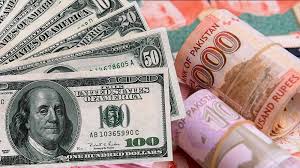Dollar to PKR Open Market
The exchange rate between the US Dollar (USD) and the Pakistani Rupee (PKR) in the open market is a key economic indicator closely watched by businesses, investors, and individuals alike. Unlike the official exchange rate set by the State Bank of Pakistan (SBP), the open market rate is determined by supply and demand dynamics in the foreign exchange market. This article will explore what the dollar to PKR open market rate is, how it works, and its impact on the economy and individuals.
The dollar to PKR open market rate is a critical economic indicator that reflects the real-time value of the Pakistani Rupee against the US Dollar. It affects various aspects of the economy, from inflation and trade to foreign debt and remittances. By understanding the factors that influence this rate and staying informed about the latest market trends, you can make more informed decisions when dealing with foreign currency. Whether you’re a business owner, investor, or individual managing your finances, keeping an eye on the open market rate is essential for navigating the complexities of the forex market.
1. What Is the Open Market Rate?
The open market rate, also known as the market exchange rate, is the price at which currencies are traded freely in the open market. It is influenced by a variety of factors, including demand for the currency, global economic conditions, political stability, and speculative activities. The open market rate for the dollar to PKR can differ from the official exchange rate, which is regulated by the central bank.
In Pakistan, the open market rate is particularly significant because it reflects the real-time value of the rupee against the dollar. This rate is used by currency exchange businesses, banks, and individuals engaging in foreign exchange transactions.
2. Factors Affecting the Dollar to PKR Open Market Rate
Several factors contribute to the fluctuations in the dollar to PKR open market rate:
- Supply and Demand: The most fundamental factor is the balance of supply and demand for the US Dollar in Pakistan. When the demand for dollars increases, perhaps due to higher import payments or more people needing to send money abroad, the dollar strengthens against the rupee, leading to a higher exchange rate.
- Political Stability: Political events and stability in Pakistan play a significant role. Any uncertainty or instability can lead to a loss of confidence in the rupee, causing it to weaken against the dollar.
- Economic Indicators: Indicators such as inflation rates, GDP growth, and trade deficits influence the open market rate. A strong economy tends to support a stronger currency, while economic difficulties can lead to depreciation.
- Global Economic Trends: Global trends, such as the strength of the US economy or geopolitical tensions, can affect the dollar’s value globally, which in turn impacts the dollar to PKR rate.
- Speculation: Currency traders and investors speculating on future movements of the dollar to the PKR rate can also cause short-term volatility in the open market.
3. How the Open Market Rate Differs from the Official Rate
The official exchange rate is set by the State Bank of Pakistan and is usually lower than the open market rate. The official rate is used for government transactions, trade settlements, and certain regulated financial activities. The open market rate, on the other hand, is used for most private transactions, such as remittances, travel money, and private sector imports and exports.
One of the key differences is that the official rate is more stable and controlled, whereas the open market rate fluctuates more frequently based on real-time trading activities.
4. Impact of the Dollar to PKR Open Market Rate on the Economy
The dollar to PKR open market rate has significant implications for various aspects of Pakistan’s economy:
- Inflation: A higher open market rate generally leads to increased import costs, as more rupees are required to purchase the same amount of goods priced in dollars. This can contribute to inflation, raising the prices of goods and services in the local market.
- Imports and Exports: The exchange rate directly affects the competitiveness of Pakistani goods in the international market. A weaker rupee makes exports cheaper and more attractive to foreign buyers but increases the cost of imports, potentially leading to a trade deficit.
- Foreign Debt: Pakistan’s foreign debt is often denominated in dollars. When the rupee weakens against the dollar, the cost of repaying this debt increases, adding to the country’s financial burden.
- Remittances: Many Pakistanis living abroad send money back to their families in Pakistan. A higher dollar-to-PKR rate means that these remittances are worth more in rupee terms, which can be beneficial for the recipients. Also, choose the safe and secure money transfer services in Pakistan.
5. How to Stay Informed About the Latest Open Market Rates
Given the importance of the dollar to the PKR open market rate, staying informed is crucial for anyone involved in foreign exchange transactions. Here are some ways to keep track of the latest rates:
- Currency Exchange Websites: Websites and apps that specialize in currency exchange, such as XE.com or local platforms like Pakistan Forex, provide real-time updates on the open market rates.
- Local Exchange Bureaus: Currency exchange bureaus display the latest rates at their offices. Visiting a bureau or checking their website can give you the most accurate rate for immediate transactions.
- Financial News Outlets: Regularly following financial news through TV channels, newspapers, or online sources can keep you updated on broader economic trends affecting the exchange rate.
- Bank Notifications: Some banks offer services where they notify you of exchange rate changes via SMS or email, especially if you hold accounts in multiple currencies.
6. Tips for Exchanging Currency in the Open Market
If you need to exchange currency in the open market, consider the following tips to get the best rate and avoid potential pitfalls:
- Compare Rates: Don’t settle for the first rate you see. Different exchange bureaus might offer slightly different rates. Comparing a few options can help you get a better deal.
- Timing: Exchange rates can fluctuate throughout the day. If possible, monitor the trends and choose a time to exchange when the rate is more favorable.
- Negotiate: In some cases, especially if you’re exchanging a large amount of money. You can negotiate a better rate with the exchange bureau.
- Avoid Weekends and Holidays: Exchange rates can be less favorable on weekends and holidays when the market is less active. If possible, plan your transactions during regular business days.
- Watch Out for Hidden Fees: Some exchange bureaus might offer an attractive rate but charge hidden fees or commissions. Always ask about any additional charges before completing your transaction.
7. The Role of the Open Market in Economic Stability
The open market plays a crucial role in economic stability, acting as a barometer for the overall health of the economy. When the rupee depreciates sharply in the open market. It can signal underlying economic issues such as rising inflation, increasing debt, or declining investor confidence. Conversely, a stable or appreciating rupee in the open market reflects positive economic sentiments and can boost investor confidence.
However, the open market is also susceptible to speculation, which can sometimes exaggerate these trends. For policymakers, maintaining a balance between the official and open market rates is important to avoid severe economic distortions.
8. Understanding the Impact of Global Events
Global events can have a significant impact on the dollar to PKR open market rate. For example, changes in US monetary policy, such as interest rate hikes by the Federal Reserve, can strengthen the dollar globally, leading to a higher exchange rate in Pakistan. Similarly, geopolitical tensions, such as conflicts in the Middle East or trade disputes between major economies, can cause fluctuations in the global currency markets, including the dollar to PKR rate.
Staying informed about global developments and understanding their potential impact on the exchange rate can help you make better financial decisions, whether you’re investing in foreign currencies, planning international travel, or managing business transactions.
















